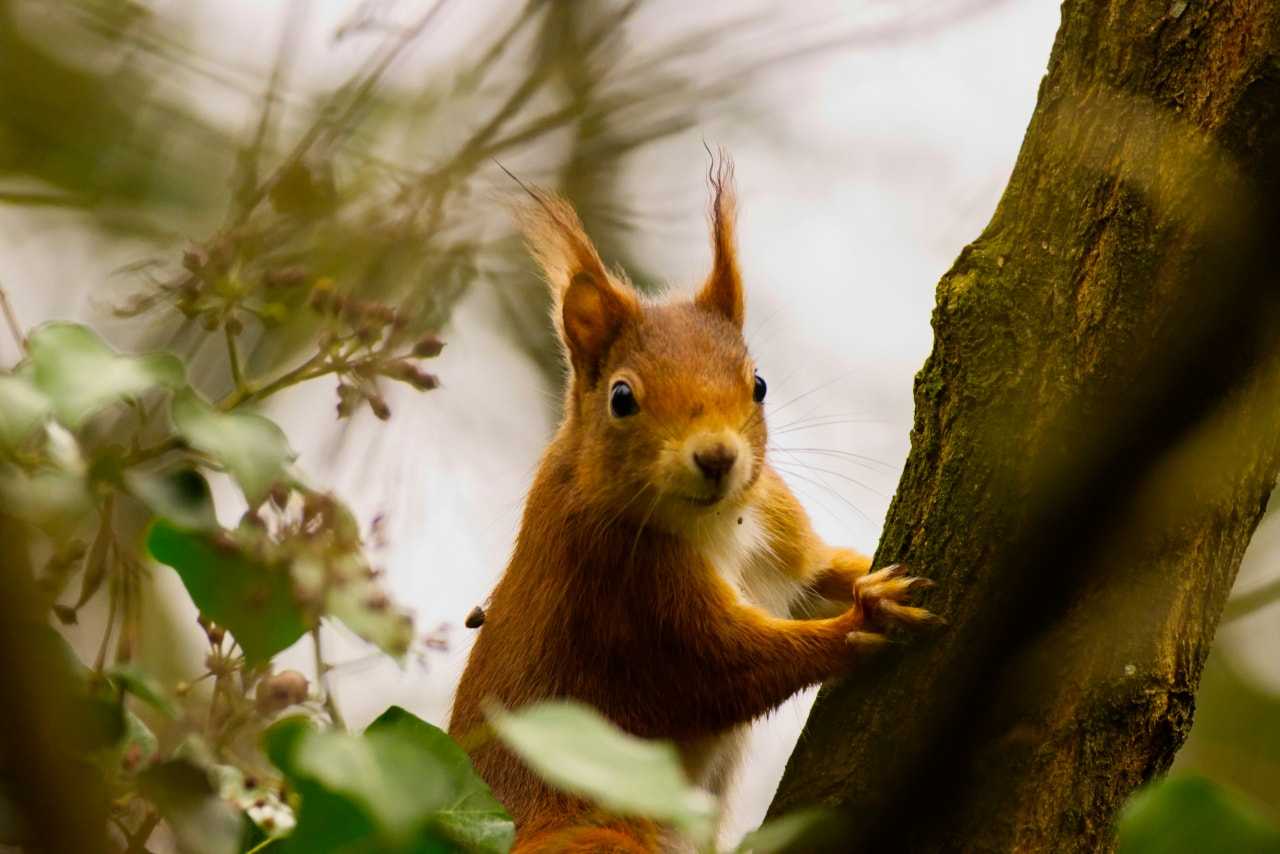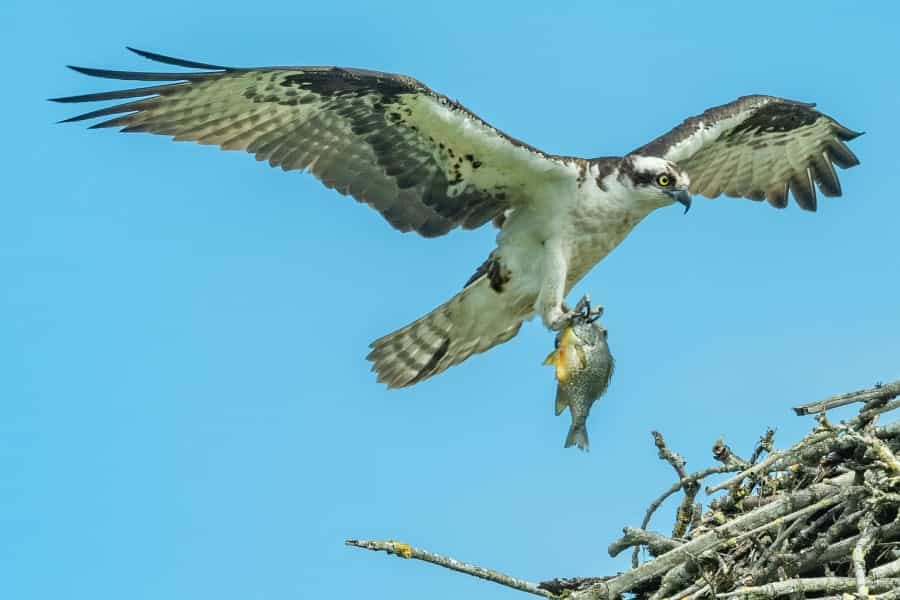Cairngorms Wildlife Watching

With several varied habitats and a lot of remote unpopulated areas across its 1,748 square miles of land, the Cairngorms National Park is a true haven for British wildlife – and therefore a hotspot for wildlife enthusiasts too. Whether you're making wildlife photography or birdwatching the main focus of your trip or including wildlife spotting as one of many activities, there is a huge amount of natural interest here for visitors.
The natural landscapes of the Cairngorms – covering mountains, lakes and forests – are spectacular to look at, and they’re also vital habitats for a range of wildlife, including some you won’t see in their natural environment anywhere else in the UK.
From red squirrels and pine martens to rare birds like capercaillies and ospreys, read on for Pitchup's guide to seeing the wildlife of the Cairngorms National Park.
The rich biodiversity of the Cairngorms
The landscape of the Cairngorms is wild and varied – the national park has around a quarter of Scotland's native forest, along with moorlands, wetlands and alpine-like semi-tundra habitats. These environments make for a rich biodiversity of flora and fauna, with the unique ecosystems being home to around 25% of Britain’s rarest wildlife.
Among the rare mammals living in the Cairngorms are pine martens, Scottish wildcats and mountain hares; it's also one of the best places in the UK to spot and photograph red squirrels. Birdwatchers may be able to see ospreys, snow buntings, golden eagles and capercaillies, and there are also lots of rare butterflies and flowers (including the pretty twinflower) to look out for.
Within the national park are nine national nature reserves specifically dedicated to preserving, maintaining and improving particular habitats. Around the rest of the park the more remote areas are kept completely natural, although several conservation projects monitor wildlife populations and help things along where possible.
Prime wildlife-watching locations
You may well catch glimpses of some of the area’s flora and fauna while out on a hike or cycle ride in the Cairngorms, but if you’d like to focus on wildlife and learn a bit more about it, there are several great locations around the national park. We’ve listed a few of the best here.
Loch Garten

A couple of miles from Boat of Garten, Loch Garten holds a special place in British wildlife history as the place where ospreys were brought back from the brink of extinction. A single breeding pair nested here in 1958 and became the original residents of RSPB Scotland's Loch Garten Osprey Centre. These days, visitors can expect to see all sorts of birds, plus lizards and squirrels, on a walk through the pine forest.
It’s free to visit Loch Garten if you're an RSPB member; otherwise there is a small charge. The visitor centre has toilets and a shop, and there are several accessible areas.
Best time to visit: Come along in spring or early summer to see breeding ospreys, woodpeckers and crested tits.
Cairngorms Plateau
The semi-tundra habitat of the Cairngorms Plateau is unique in the UK, so if you make your way to this remote area in the centre of the national park you may be able to spot wildlife you won't see anywhere else in the country. Bring binoculars and good camera kit for the chance to catch glimpses of ptarmigans, snow buntings, golden eagles, snowy owls and mountain hares.
Several of the country's highest peaks sit around the plateau, so you may be able to combine wildlife spotting with bagging a munro or two.
Best time to visit: Late spring through to early summer are the best times to visit for bird watching.
Rothiemurchus
Easily accessed from the A9 and with plenty of facilities and activities, the Rothiemurchus estate is a great place for an introduction to the wildlife of the Cairngorms, especially if you’re visiting with children. Red deer, red squirrels and pine martens all thrive here, along with lots of birds including crossbills, buzzards and capercaillie.
The estate has a café and farm shop as well as several well-marked walking trails taking in lakes and forest views. Book ahead for wildlife workshops such as osprey photography and deer feeding, or other activities like fishing, horse riding and rafting.
Best time to visit: The estate is open all year, but certain activities are seasonal – spring is the time for guided tours to see capercaillie.
Insh Marshes
RSPB Insh Marshes is one of Europe's most important wetlands, and a key breeding ground for wading birds such as lapwings, snipes and curlews. The 10 square kilometres of marshland on the River Spey floodplain are being carefully brought back to their natural state by the RSPB after years of being used for grazing habitat, making this a vital conservation area as well as an excellent place for birdwatching. There are three nature trails to follow here, with picnic benches along the way (pick up supplies in nearby Kingussie).
Best time to visit: Bird numbers are at their highest during the spring and autumn migration seasons.
Highland Wildlife Park
Getting out into the wild landscapes of the Cairngorms is the best way to see the park's wildlife in its natural habitat, but if you're short of time, travelling with kids or want a guaranteed sighting of something in particular, take a trip to the Highland Wildlife Park. Just off the A9 between Kingussie and Aviemore, the park is home to a number of native species (such as red squirrels and red deer) as well as more exotic animals including monkeys, polar bears and camels.
Education and conservation are the heart of this park, so it’s worth checking out their programme of daily talks and special workshops if you'd like to learn a bit more about the animals.
Seasonal wildlife highlights
There’s something to be seen in the Cairngorms during every season, but breeding and migration patterns mean that wildlife populations change throughout the year. Here’s a brief guide to the different kinds of flora and fauna you might be able to see in different seasons.
Spring
Spring tends to take a while to get going in the Cairngorms, with snow often sticking around until April or even May. Wildflowers start to bloom at lower elevations earlier on, however – and that mix of colourful flowers and snow-capped peaks makes for some beautiful photography conditions.
Migratory birds – including ospreys and warblers – return to the Cairngorms to nest in spring, and it's also the time for black grouse to put on their mating displays, the males gathering in small groups to strut and call to attract the females. Spring is also a good time to visit the Cairngorm Reindeer Centre, as the free-ranging herd welcomes new calves.
Summer
Most of the area's wildlife is at its most active during the summer months. Osprey chicks usually hatch around late May/early June, so the parents will be out fishing a lot in the early summer months. There are plenty of other birds making the most of the long daylight hours at this time, too – including snow buntings, ptarmigans and wading birds like curlews and oystercatchers.
Most mammals will have bred by the summer, so you may be able to spot young red squirrels, pine martens and badgers. The lower light of dusk is their favourite time to forage, so evening is likely to be your best time to see them out and about.
Autumn
As the trees start to change colour, the Cairngorms’ red deer populations move to lower altitudes, giving visitors a better chance of seeing them. September to November is also their rutting season, when the roaring and clashing of antlers make for a spectacular display.
Many birds are preparing for their winter migrations during this time, with a real highlight being the migration of the geese – large numbers can often be spotted flying overhead on settling on a loch. Other species get ready for the colder months by changing colour – the ptarmigan is one of these, going from brown to snowy white.
At ground level, lots of mushrooms appear during the autumn months, making this a great time for foraging or rare species spotting.
Winter
Winter can be harsh in the Cairngorms – it's the coldest part of the UK, so both animals and visitor numbers tend to be lower. Venture out into the semi-tundra landscapes at this time and you may see mountain hares, golden eagles, snow buntings and ptarmigans in their winter coats.
Many of the more elusive animals (like mountain hares and otters) favour remote locations, so you'll need to track their footprints through the snow if you hope to see them. However, other animals will in fact migrate towards population centres in colder weather – red deer often move towards villages if they think there's a food source, and small birds have learned there may well be crumbs to pick up at local ski centres.
Conservation efforts and visitor impact
Much of the wildlife in the Cairngorms is rare or even endangered, so it's absolutely vital that visitors to the area do their best to disturb the animals as little as possible and have minimal impact on the environment.
7 tips for responsible wildlife watching
-
Keep a safe distance, using binoculars and long-range cameras to get your close-ups
-
Leave dogs at home where possible, but keep them on a lead at all times of you do bring them
-
Look out for ground-nesting birds as well as those in the trees
-
Don’t wear strong perfume or other scent as this can be confusing for wildlife
-
Never approach a young animal or its mother
-
Leave no trace – this includes not disturbing any branches, leaves or stones as well as taking your litter away
-
If available, join a guided tour with a local expert who will be able to maximise your chances of a spotting while also understanding the habitat
Cairngorms conservation projects
As well as large-scale conservation projects run by the national park aimed at protecting and expanding woodland and peatland areas, there are a number of projects running within the park that focus on particular species. You can help to support these by visiting, volunteering time or donating money – look out for various options at some of these projects:
Planning your trip
With stunning landscapes, varied terrain and lots of rare animals to spot, the Cairngorms is surely one of the best wildlife-watching locations in the UK. There are many ways to get out and explore the area, including high-altitude hikes, easygoing nature walks, expert-led tours and family-friendly introductions to nature. It’s also an area that rewards visitors with amazing sights throughout the year – from spotting mountain hares in the winter snow to watching ospreys nest in spring and experiencing the autumn deer rutting season.
Whether you're visiting the Cairngorms solely to see the wildlife, or just hoping for sightings around other activities, you can maximise your time in nature and your chances of wildlife encounters by staying outdoors. Wild camping is permitted in Scotland, and Pitchup has a good range of campsites and cabins for those who prefer to have a few facilities on hand.